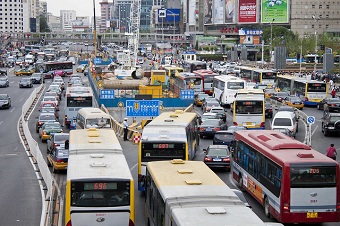Beijing considers cutting car use in half
 In 2008, as Beijing prepared to showcase itself to the world for the 2008 Olympics, city officials required that millions of cars stayed off the roads. The results of this drastic effort to reduce air pollution were clear as smog subsided. Years later researchers showed just how much of an impact the measure had on emissions. But when the games were over, the typical traffic congestion was back along with the air pollution.
In 2008, as Beijing prepared to showcase itself to the world for the 2008 Olympics, city officials required that millions of cars stayed off the roads. The results of this drastic effort to reduce air pollution were clear as smog subsided. Years later researchers showed just how much of an impact the measure had on emissions. But when the games were over, the typical traffic congestion was back along with the air pollution.Now, Beijing is considering a more permanent plan to ease traffic congestion. The plan looks to cut car use in half by requiring cars with odd and even numbered license plates to alternate when and where they can drive, China Daily reports.
It’s surely an enticing move for city officials. During the Olympics, traffic on major roads was reduced by a staggering 21 percent while the time it took to get around increased by 27 percent. But is a plan like this the best one for the city, businesses, and its people?
With 5 million cars in the Chinese capital, the city is already restrictive with cars and car use. Drivers aren’t allowed to use their car one day per week. Parking fees and a lottery system that limits new car registrations are both in place to reduce traffic congestion. It’s even planning to introduce a congestion charge (it’s worked for London). But the current measures haven’t done enough to reduce traffic.
Some don’t think this new idea is the solution:
Wang Limei, secretary-general of the China Road Transport Association, said: “I think caution is required. It could ease traffic congestion in the short term, but it can’t solve the problem at the root.
“Now drivers are restricted from the roads one day a week, which is tolerable. If they are required to drive on alternate days, it would cause much more inconvenience, and many people may very likely turn to buying a second car to circumvent the measure.”
Better planning is also pointed to as a solution to congestion problems. Others believe the city’s traffic problems could be solved with increased public transportation. And it’s a solution that Beijing is also turning to.
By the end of this year, the city expects to increase the number of miles its subway reaches to about 275, making it a larger system than in London. It also wants to increase the number of public bikes to 50,000. Chen Yanyan, a professor at Beijing University of Technology’s Transport Research Center, told China Daily: “In five to ten years, when the subway network is improved, I believe Beijing’s traffic congestion will be greatly eased.”
For now, the subway is a crowded option for commuters. Last month, riders took 210 million trips. And since last year ridership increased by 12.5 percent. But it looks like Beijing drivers will have to make everyone squeeze in a little tighter on the train, at least half the week.
You can return to the main Market News page, or press the Back button on your browser.

